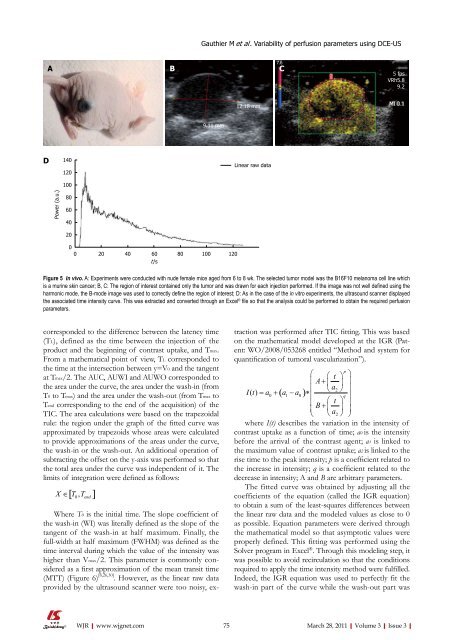3 - World Journal of Gastroenterology
3 - World Journal of Gastroenterology
3 - World Journal of Gastroenterology
Create successful ePaper yourself
Turn your PDF publications into a flip-book with our unique Google optimized e-Paper software.
D<br />
A<br />
Power (a.u.)<br />
140<br />
120<br />
100<br />
80<br />
60<br />
40<br />
20<br />
0<br />
0 20 40 60 80 100 120<br />
t /s<br />
corresponded to the difference between the latency time<br />
(TL), defined as the time between the injection <strong>of</strong> the<br />
product and the beginning <strong>of</strong> contrast uptake, and Tmax.<br />
From a mathematical point <strong>of</strong> view, TL corresponded to<br />
the time at the intersection between y=V0 and the tangent<br />
at Tmax/2. The AUC, AUWI and AUWO corresponded to<br />
the area under the curve, the area under the wash-in (from<br />
T0 to Tmax) and the area under the wash-out (from Tmax to<br />
Tend corresponding to the end <strong>of</strong> the acquisition) <strong>of</strong> the<br />
TIC. The area calculations were based on the trapezoidal<br />
rule: the region under the graph <strong>of</strong> the fitted curve was<br />
approximated by trapezoids whose areas were calculated<br />
to provide approximations <strong>of</strong> the areas under the curve,<br />
the wash-in or the wash-out. An additional operation <strong>of</strong><br />
subtracting the <strong>of</strong>fset on the y-axis was performed so that<br />
the total area under the curve was independent <strong>of</strong> it. The<br />
limits <strong>of</strong> integration were defined as follows:<br />
[ 0 ] , X ∈ T Tend<br />
Where T0 is the initial time. The slope coefficient <strong>of</strong><br />
the wash-in (WI) was literally defined as the slope <strong>of</strong> the<br />
tangent <strong>of</strong> the wash-in at half maximum. Finally, the<br />
full-width at half maximum (FWHM) was defined as the<br />
time interval during which the value <strong>of</strong> the intensity was<br />
higher than Vmax/2. This parameter is commonly considered<br />
as a first approximation <strong>of</strong> the mean transit time<br />
(MTT) (Figure 6) [8,26,30] . However, as the linear raw data<br />
provided by the ultrasound scanner were too noisy, ex-<br />
WJR|www.wjgnet.com<br />
B<br />
Gauthier M et al . Variability <strong>of</strong> perfusion parameters using DCE-US<br />
9.11 mm<br />
12.18 mm<br />
Linear raw data<br />
7.6<br />
C<br />
traction was performed after TIC fitting. This was based<br />
on the mathematical model developed at the IGR (Patent:<br />
WO/2008/053268 entitled “Method and system for<br />
quantification <strong>of</strong> tumoral vascularization”).<br />
p<br />
⎛ ⎞<br />
5 fps<br />
VRh5.8<br />
9.2<br />
Figure 5 In vivo. A: Experiments were conducted with nude female mice aged from 6 to 8 wk. The selected tumor model was the B16F10 melanoma cell line which<br />
is a murine skin cancer; B, C: The region <strong>of</strong> interest contained only the tumor and was drawn for each injection performed. If the image was not well defined using the<br />
harmonic mode, the B-mode image was used to correctly define the region <strong>of</strong> interest; D: As in the case <strong>of</strong> the in vitro experiments, the ultrasound scanner displayed<br />
the associated time intensity curve. This was extracted and converted through an Excel ® file so that the analysis could be performed to obtain the required perfusion<br />
parameters.<br />
MI 0.1<br />
⎛ t ⎞<br />
⎜ A + ⎜ ⎟ ⎟<br />
⎜ a2<br />
⎟<br />
I( t) = a0 + ( a1 − a0<br />
) ∗<br />
⎝ ⎠<br />
⎜ q ⎟<br />
⎜ ⎛ t ⎞<br />
B ⎟<br />
⎜<br />
+ ⎜ ⎟<br />
a ⎟<br />
⎝ ⎝ 2 ⎠ ⎠<br />
where I(t) describes the variation in the intensity <strong>of</strong><br />
contrast uptake as a function <strong>of</strong> time; a0 is the intensity<br />
before the arrival <strong>of</strong> the contrast agent; a1 is linked to<br />
the maximum value <strong>of</strong> contrast uptake; a2 is linked to the<br />
rise time to the peak intensity; p is a coefficient related to<br />
the increase in intensity; q is a coefficient related to the<br />
decrease in intensity; A and B are arbitrary parameters.<br />
The fitted curve was obtained by adjusting all the<br />
coefficients <strong>of</strong> the equation (called the IGR equation)<br />
to obtain a sum <strong>of</strong> the least-squares differences between<br />
the linear raw data and the modeled values as close to 0<br />
as possible. Equation parameters were derived through<br />
the mathematical model so that asymptotic values were<br />
properly defined. This fitting was performed using the<br />
Solver program in Excel ® . Through this modeling step, it<br />
was possible to avoid recirculation so that the conditions<br />
required to apply the time intensity method were fulfilled.<br />
Indeed, the IGR equation was used to perfectly fit the<br />
wash-in part <strong>of</strong> the curve while the wash-out part was<br />
75 March 28, 2011|Volume 3|Issue 3|

















